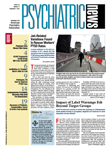New analyses of violent behavior in patients with schizophrenia have traced propensity for violent behavior in certain patients to childhood conduct problems before psychotic symptoms emerged.
A study published June 30 in the online version of Law and Human Behavior by Jeffrey Swanson, Ph.D., an associate professor of the Department of Psychiatry and Behavioral Sciences at Duke University, and colleagues suggests a pathway to violent behavior in schizophrenia linked to a developmental pattern of early antisocial characteristics.
The authors reviewed data on 1,445 adult schizophrenia patients from the Clinical Antipsychotic Trials for Intervention Effectiveness (CATIE) study and looked for associations between their history of childhood conduct problems and prevalence of violent behavior within the six months before study screening.
The definition of violent behavior included both minor (simple battery without injury or weapon use) and serious violence (assault using a lethal weapon or resulting in injury, any threat with a lethal weapon in hand, or any sexual assault). History of childhood conduct problems before age 15 was defined as positive response to at least two of the six questions designed to assess defiant antisocial characteristics in children.
The rate of violence within the preceding six months was 28.2 percent among the 488 patients who had a history of childhood conduct problems. This was twice the rate of violence (14.4 percent) among the 956 patients without a history of childhood conduct problems (none or one positive response to the six assessment questions); the difference was statistically significant.
CATIE was a national study of the cost-effectiveness of antipsychotic medications conducted from 2001 to 2004 at 56 sites across the United States and funded by the National Institute of Mental Health (Psychiatric News, April 6, March 16). The patients studied were adults aged 18 to 65 who met DSM-IV criteria for schizophrenia, were not experiencing the first episode of schizophrenia, and were treated with oral medications.
Additional analyses of the correlation between violence and childhood antisocial characteristics revealed risk-factor patterns associated with violence in the two patient groups.
In the patients with childhood conduct problems, for example, there was a statistically significant association between violence and substance use as well as a substance abuse or dependence disorder, but not between violence and positive psychotic symptomatology as measured by higher Positive and Negative Syndrome Scale positive scores. (Substance use, as opposed to abuse or dependence, refers to alcohol or illicit drug use that does not cause significant impairment, according to a study of CATIE data by the same researchers in the May 2006 Archives of General Psychiatry).
In the patients without childhood conduct problems, violence was statistically significantly associated with substance abuse or dependence disorder only and with positive psychotic symptomatology, but not with substance use. The two groups of patients did share several other risk factors also significantly associated with violence, including younger age, lack of substantial vocational activity, residing with family or other relatives, and recent involvement with the police.
The researchers discussed two theories that may explain the findings. First, the childhood antisocial tendency may be an early sign of an underlying pathology in a subgroup of schizophrenia patients prone to violence in adulthood. Or it may be that a subtype of patients has characteristics of comorbid antisocial personality disorder separate from psychosis.
“This study is an important contribution to the understanding of pathogenesis of violent behavior in schizophrenia patients. It is consistent with previous observations that violent patients with schizophrenia have high ratings on the psychopathy scale and that only about 20 percent of violent incidents in psychotic inpatients is directly attributable to positive symptoms,” commented Jan Volavka, M.D., Ph.D., a professor emeritus of psychiatry and a research professor of psychiatry at New York University School of Medicine and the author of the book Neurobiology of Violence.
“The study indicates that much of the violence in schizophrenia is not directly related to psychosis. It is therefore not likely to respond to antipsychotic medication,” Volavka said. Although treatment for violent behavior in this subpopulation is not well established, he pointed to previous studies that suggest long-term, cognitively based, behavioral treatment may be helpful to some schizophrenia patients with persistent violent behavior not directly related to psychotic symptoms.
An abstract of “Alternative Pathways to Violence in Persons With Schizophrenia: The Role of Childhood Antisocial Behavior Problems” is posted at<www.springerlink.com/content/c718739702076675/?p=0d39f6b1aa8847eab14d224ef6969fa1&pi=5>.▪
